How To Reduce Overtime: Strategies for Employees and Managers
As a recovering overtime addict who’s also been through burnout, I know that the overtime issue is two-sided, and it should be tackled from both perspectives: the employee and the direct report.
That’s why, in this article, I’ll teach you what should both managers and team members do to reduce overtime. Let’s dive right in and explore practical tips on how to reduce overtime hours.
Key takeaways
- Productivity cliff: Stanford research demonstrated that someone working past 50 hours per week has a dramatic productivity decline once those total hours are reached, while error rates jump 23% in 12+ hour workdays.
- Overtime costs are typically 1.5-2 times the regular wages.
- As a team leader, when assessing overtime, address its root causes before jumping to conclusions. These can be workload imbalances, skill gaps, and time management challenges.
- As an employee, practicing “professional detachment,” filling your cup with personal hobbies outside work, and communicating realistic timelines for late requests are some strategies that protect you against overtime.
What is overtime?
Overtime hours are extra hours that you or your team spend at work that are beyond the regular work hours, like the generally accepted 40 hours per week. Employee overtime hours are regulated in many countries by labor laws, which define overtime, and it is calculated and compensated. Overtime pay is typically set at a rate higher than the regular hourly wage to incentivize employers to limit extra work hours.
What’s particularly concerning about overtime is how quickly it becomes normalized.
What starts as occasional late nights gradually becomes an expectation. That is, both the employer expects the team member to deliver as expected, and the employee sets expectations of overdelivering from oneself. Before you know it, consistently working past regular hours becomes part of your work identity, and that’s how you reach a dangerous territory that leads straight to toxic productivity.
Timeular is a 100% effortless overtime tracker that helps you capture work time and overtime with ease
Why is it important to reduce overtime?
While overtime is glorified and seems like a badge of honor, it comes with massive costs for everyone. I’m not talking only about having extra paychecks for overtime and health costs; I’m talking about higher error rates at work, increased turnover, and others.
Let’s explore some of these costs:
- Decreased productivity: A Stanford University study demonstrated that productivity dramatically declines after 50 hours of work per week. The study proved that someone’s output falls sharply after 55 hours, and someone working 70 hours produces nothing more than someone working 55 hours. I’ve experienced this firsthand all these excessive overtime hours led me to nothing more than my burnout. Note: The mentioned studies are linked at the bottom of the article.
- Higher error rates: When working unnecessary overtime hours, fatigue comes with serious effects. Another study from the Occupational & Environmental Medicine journal found that working 12+ hour days increased error rates by 23%. It’s understandable if you’re thinking about how many times you caught a silly mistake you made at the end of a long day, right?
- Health implications: There is no novelty in the fact that overtime costs us our health. McKinsey Health’s 2022 survey documented this connection between burnout and heavy workload. They surveyed 15,000 workers across 15 countries, among which a quarter reported experiencing burnout symptoms directly linked to excessive overtime hours.
- Financial costs: When employees work overtime hours, overtime pay typically costs 1.5-2 times the regular wages. At the end of the month, when you calculate labor costs, you uncover a high financial burden without the outputs increasing proportionally instead of an improved business efficiency.
- Increased turnover: A Gallup poll proved that burnout is directly correlated with turnover intentions. Among the surveyees 23% of employees report feeling burned out “very often” or “always,” with another 44% feeling burned out “sometimes.”
💡 Pro tip: Not sure what’s your company’s financial impact of extra hours? Use this free overtime calculator to quantify your costs. Managers we worked with were shocked to discover just how much those extra hours cost when factoring in reduced productivity, increased error rates, and potential burnout.
Ways to reduce overtime hours for managers
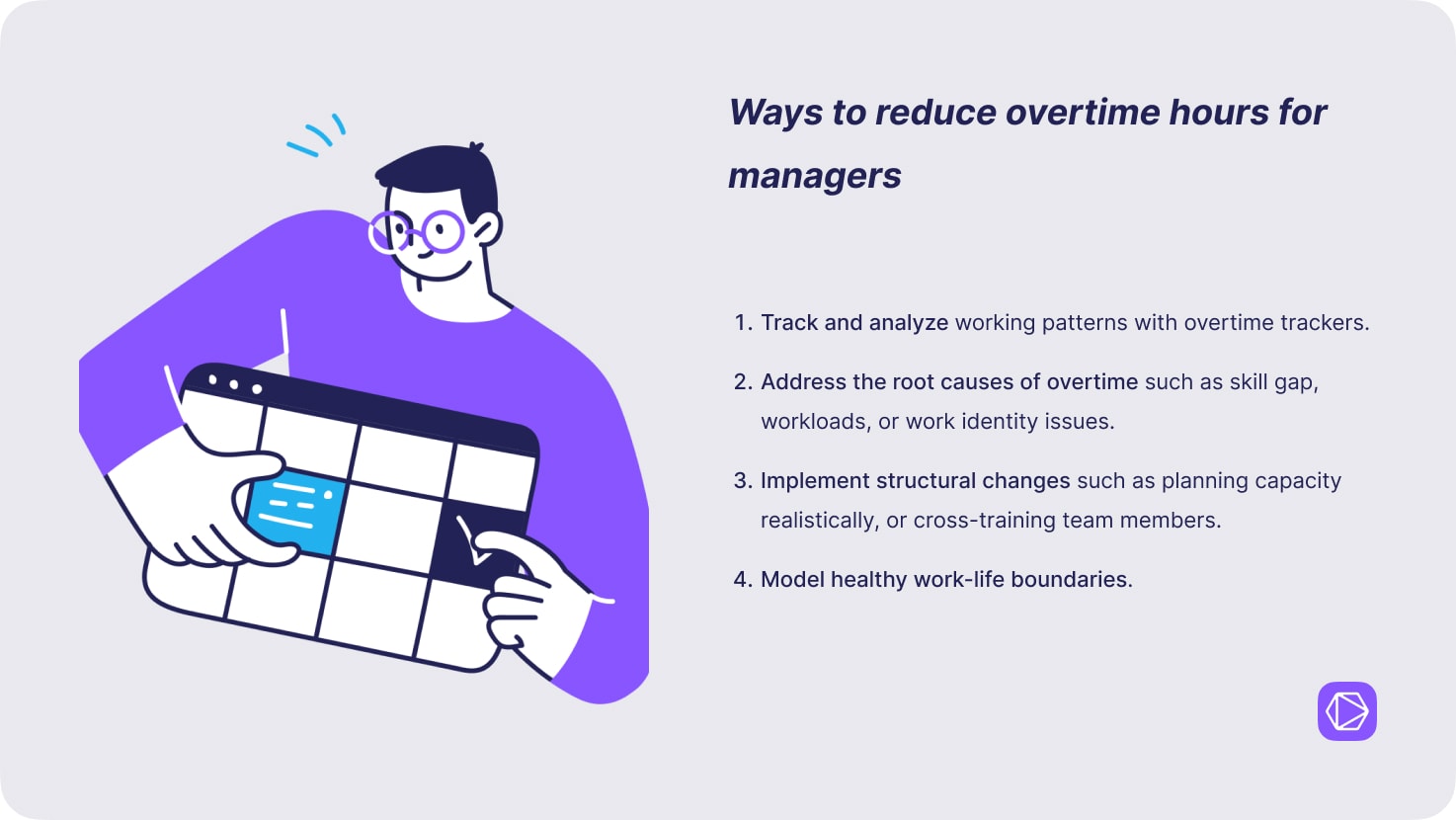
Tips for managers
As a manager, you can influence your team’s work patterns to help them reach a healthy work-life balance. Here’s how you can help reduce overtime step by step:
1. Track and analyze working patterns
First of all, before reducing employee overtime hours, identify why you and your team got to this point.
- Use an overtime tracker to see objectively your team’s overtime in the workplace. It’s best if you try non-invasive tools like Timeular to help you and the team understand work patterns without feeling surveilled. I use Timeular with my team of writers, and the insights have been eye-opening as we discovered one writer was spending 70% of her time in meetings, as she was the best in taking client calls, but this left little time for focused work, which was something she desired.
Timeular is a 100% effortless overtime tracker that helps you capture work time and overtime with ease
- Look for patterns: Are overtime hours concentrated around specific projects, deadlines, or team members? Is it occasional (big launches to push for, seasonal peaks) or systematic and consistent? This way, you’ll know if capacity planning is the issue or busy periods in which your industry is always at high speed. One of my clients discovered that overtime spiked during the last week of each quarter, which is normal for their specific industry, but they realized they could also alleviate their teams with better planning.
- Measure actual work hours: Many employees work “invisible overtime” by not logging hours officially. Create a safe environment where team members accurately report their time. Ask them directly: “Are you logging all your hours? I want to understand our true capacity so we can plan better.”
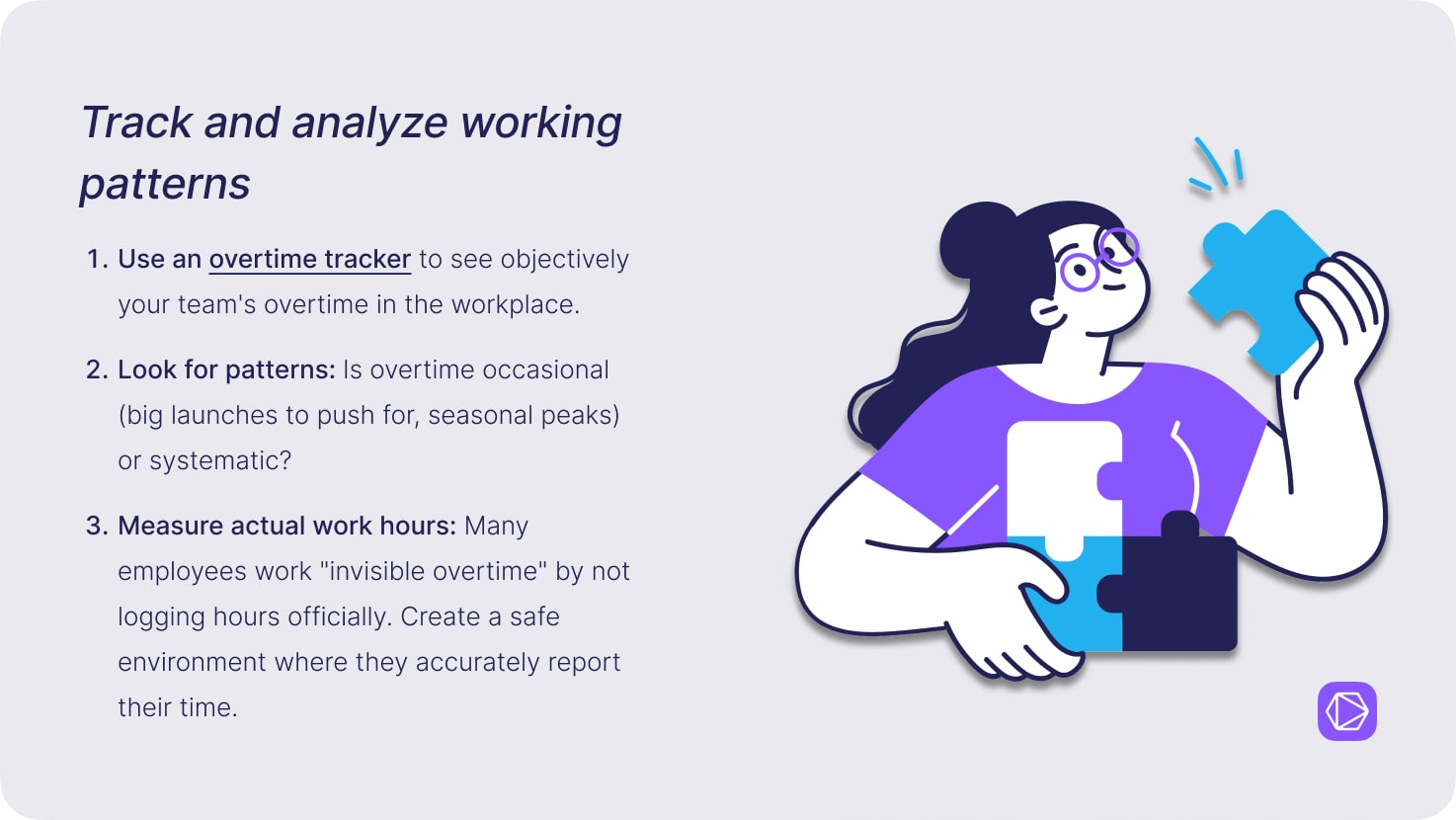
2. Address root causes of overtime
When you notice consistent overtime patterns, have honest conversations with your team and try to identify the root causes.
- Workload assessment: Start by asking directly: “I’ve noticed you’re consistently working late. Is your workload manageable, or is it too much?” Listen without judgment. I once had a manager who noticed my late-night emails and simply asked me, “What can I take off your plate?” That conversation changed everything for me, both how I discuss with my managers and how I perceive work overaload in general.
- Skill gaps: Sometimes, employees work overtime to compensate for lacking specific skills. This can be a difficult conversation as your team can see it as confrontational, so you need to handle it wisely. Ask them: “Do you have all the knowledge and tools needed for your responsibilities?”. Cross-training employees is the best solution at all times, as maybe they don’t know how to work efficiently with specific software or processes that are taking longer than they should.
- Time management challenges: Is it that they don’t know how to manage their time? Poor time management is often the culprit of long employee schedules and inefficiency. Bring in experts who know how to teach time management efficiently and share with your team tools to handle their time.
- Work identity issues: Some employees tie their self-worth to their work output. That was my case, too. While you’re not their therapist, you can help them by recognizing achievements beyond pure productivity metrics. I had a team member who worked late because she thought that’s what “committed employees” do until we discussed how quality thinking, not hours worked, was what we valued.
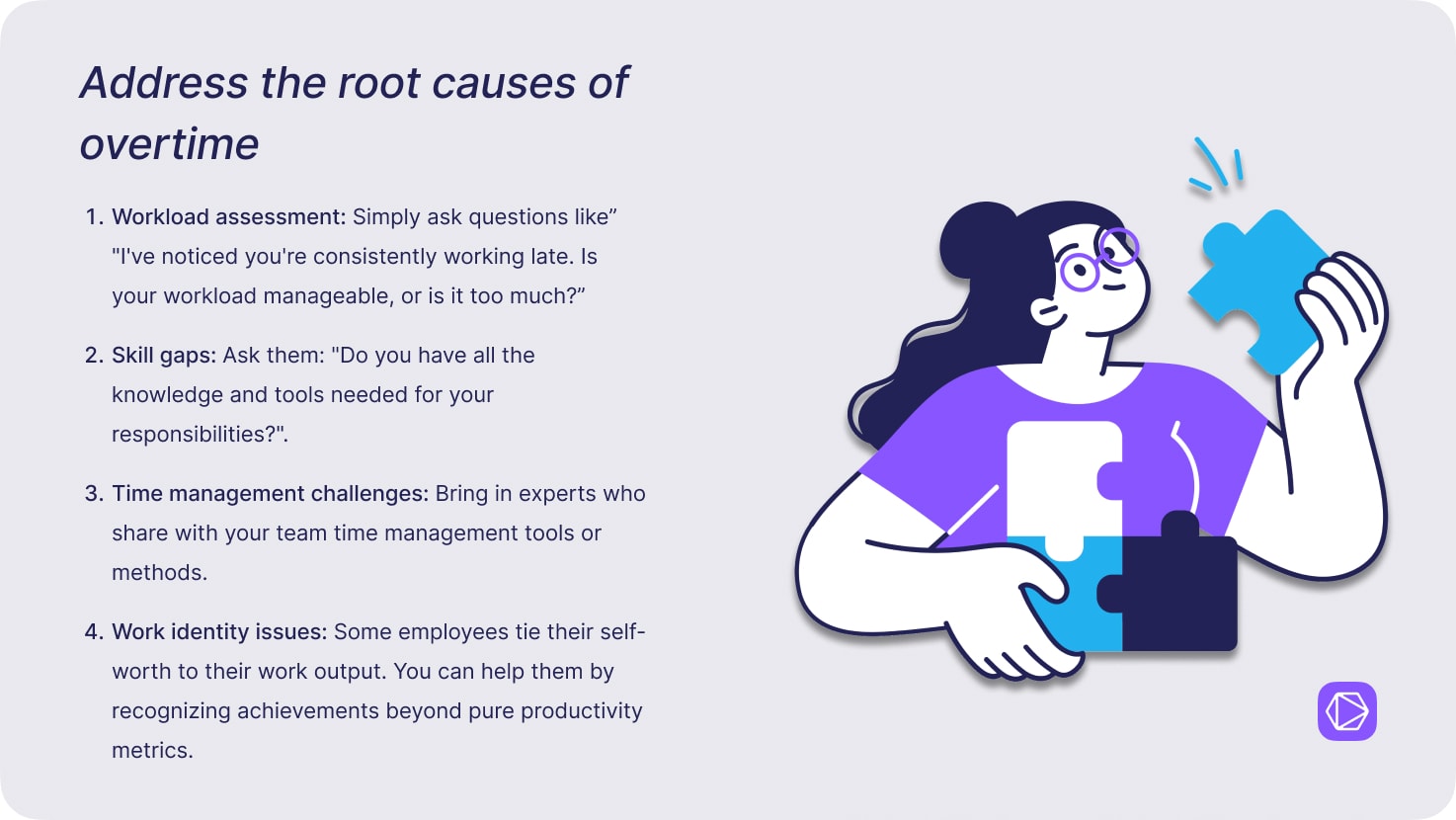
3. Implement structural changes
After identifying root causes, make systemic changes that last and shift behaviors within your team.
- Plan capacity realistically: Use the data revealed in tracking time to plan estimates and plan resource allocation for projects with more accuracy. If your team consistently needs 30% more than your initial time allocation, stop pretending the next project will be different.
- Prioritize ruthlessly: Be clear about what work is truly essential versus what can wait or be eliminated. Don’t be afraid to delegate tasks and redistribute them from one employee to another. I like asking my team, “If we could only do three things this quarter, what would they be?” It helps us remove the noise and the nice-to-haves and builds employee morale.
- Improve tools and processes: Ask your team what tech or procedural bottlenecks slow them down. Something as simple as automating project cost tracking saved my team hours each month.
- Cross-train team members: Build redundancy so that work doesn’t pile up when someone is out. In one of my previous jobs, we implemented “knowledge-sharing Fridays,” where team members would teach others about a process only they knew and it reduced our vulnerability to single points of failure.
- Consider flexible work schedules: Sometimes the problem isn’t the total hours worked but when they’re worked. Flexible employee schedules reduce overtime as these accommodate different productivity rhythms. One of my most productive team members does her best work from 7 am-3 pm, while someone else prefers 11 am-7 pm. Accommodating both reduced their need for overtime.
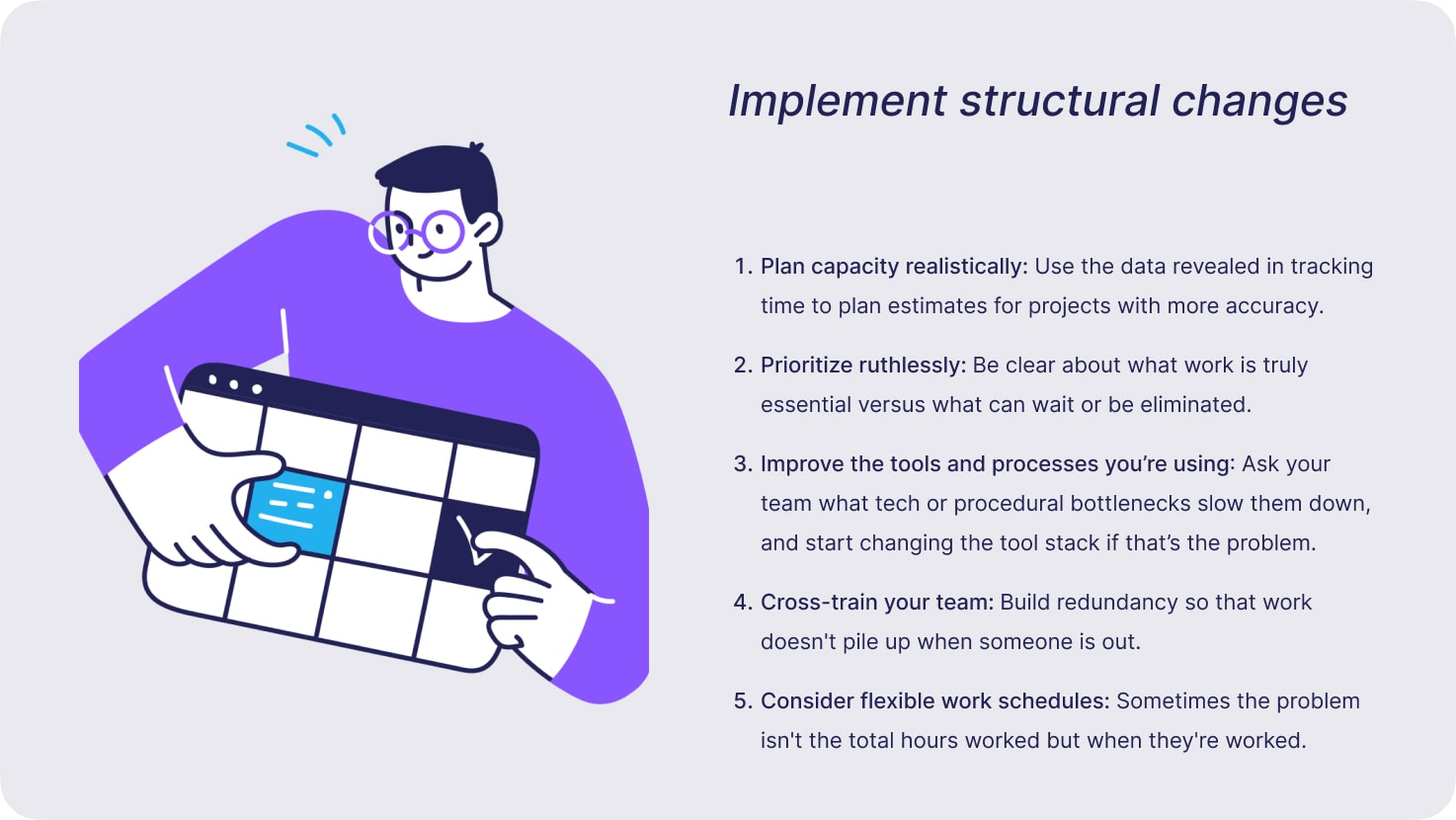
4. Model healthy work-life boundaries
Your behavior as a manager sets the tone. If you regularly send emails at 10 PM, you’re implicitly communicating that after-hours work is expected and normalized, regardless of what you say explicitly.
- Respect off-hours: Avoid emailing or messaging your team outside working hours unless truly urgent. If you must send that late-night email, add a note saying, “No need to respond until tomorrow morning.”
- Take your time off: Use your own time off and fully disconnect when you do. One manager I respect puts “I’m on vacation with no access to email” in her out-of-office message, setting a clear expectation that she won’t be secretly checking in.
- Talk about your boundaries: Share how you protect your own work-life balance to normalize these conversations. I tell my team about my phone-free evenings between 6-8 pm for family dinner, which gives them permission to have their own boundaries.
- Celebrate efficiency: Recognize team members who accomplish their work efficiently within normal hours rather than only praising those who put in extra time. At our monthly reviews, I make a point to highlight someone who improved a process, not just those who stayed late to get things done. Celebrating only those who went above and beyond and put in extra hours is a toxic behavior on your side and only leads to employee burnout.
5. Create a cultural shift
Overtime is often deeply embedded in company culture, but you can change your team’s overtime policy without changing the company’s official overtime policy. Changing it requires intention and the following ways:
- Discourage presenteeism: Make it clear that staying late isn’t a signal of commitment or productivity. In one office I worked in, the manager would walk around at 6 pm asking people why they were still there, which completely flipped the script on what was valued.
- Measure outputs, not hours: Focus evaluations on results achieved rather than time spent. During performance reviews, I never mention hours worked but only impact created, problems solved, and goals achieved, which always makes my team understand that they need to improve work efficiency rather than something else.
- Normalize saying no: Support team members when they push back on unrealistic deadlines or additional work that exceeds capacity. When my team member told an executive, “We can take that on, but it means delaying the Johnson project,” I publicly backed her decision.
💡 Pro tip: Saying no to work is hard, I know, but I promise you’ll love the framework I found and wrote all about it in the How to say no at Work article.
- Check workload regularly: Discuss sustainable workloads as a standard practice in your team meetings. A simple “traffic light” system (green, yellow, red) can quickly identify who’s feeling overwhelmed before it becomes a crisis.
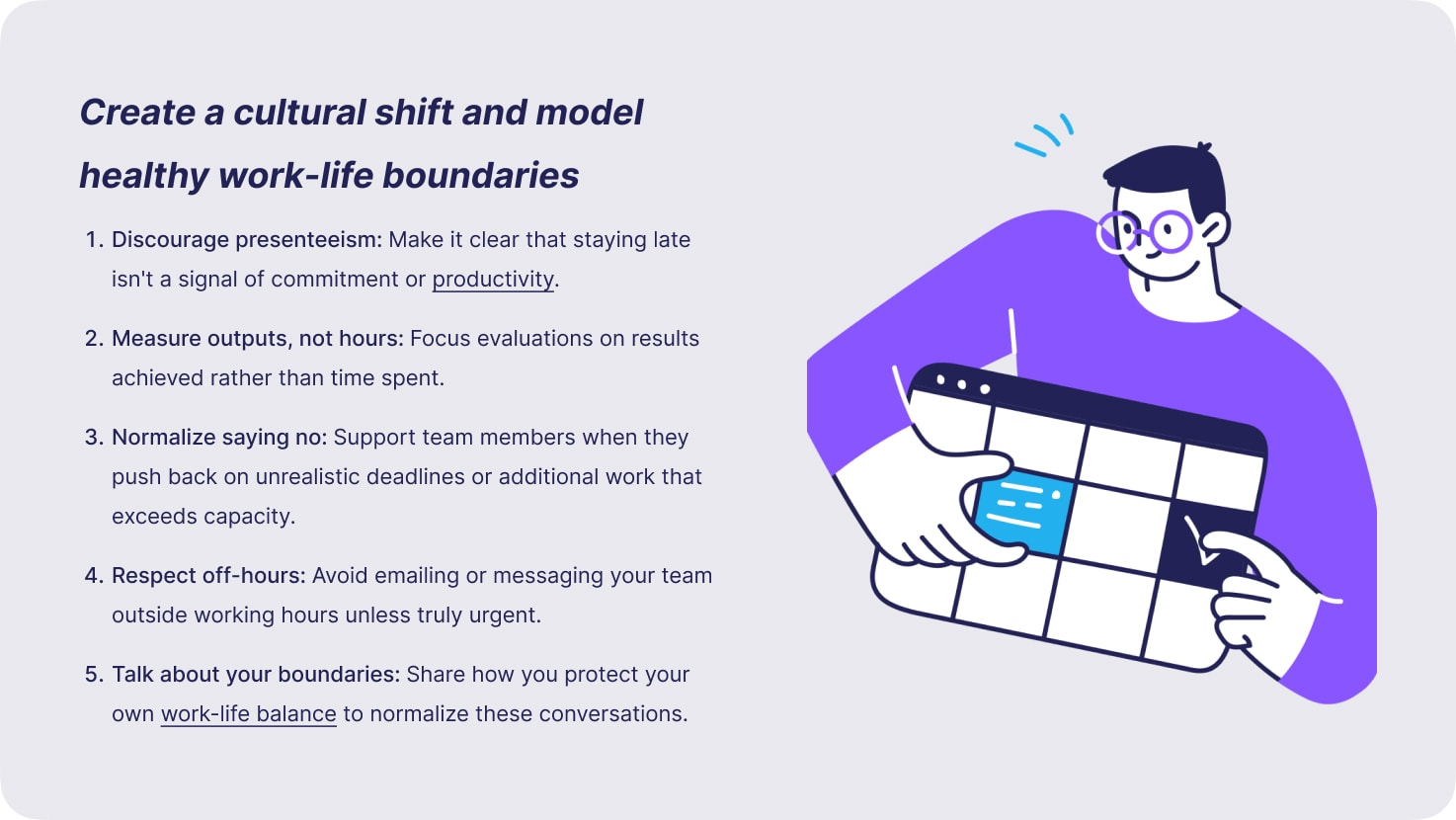
Tips for employees
While organizational changes are pivotal in changing your work patterns, you also have a lot of agency in addressing overtime habits. Here are some tips you can follow:
1. Detach your identity from your work
One of the biggest drivers of voluntary overtime is what Laurie Ruettimann calls a lack of “professional detachment,” which is the belief that your value equals your output.
- Remember that you are more than your job: Your job is just one identity. You’re also a friend, family member, community participant, and individual with unique interests and needs. I used to think being a workaholic made me important, as I took most of my validation from my work until I realized I did not really grow any other identity in my personal life and was slowly losing my friendships and hobbies.
- Set clear boundaries: Define when your workday begins and ends, and communicate these boundaries to colleagues. I tell new coworkers upfront that I’m unavailable after 6 pm except for genuine emergencies.
- Practice saying, “I’ll get to that tomorrow.” Not everything needs to be done now. Train yourself to assess urgency realistically instead of treating every request as a fire that must be extinguished immediately. That’s smart and effective time management. When a colleague sends a non-urgent request late in the day, respond with “I’ve noted this and will address it first thing tomorrow” rather than staying late to handle it
- Fill your cup outside work: Grow hobbies and relationships that give you satisfaction beyond your professional achievements. This way, you learn to rely on things outside of work to make you feel good and fulfilled. Also, multiple sources of meaning in your life create resilience when work is stressful or disappointing.
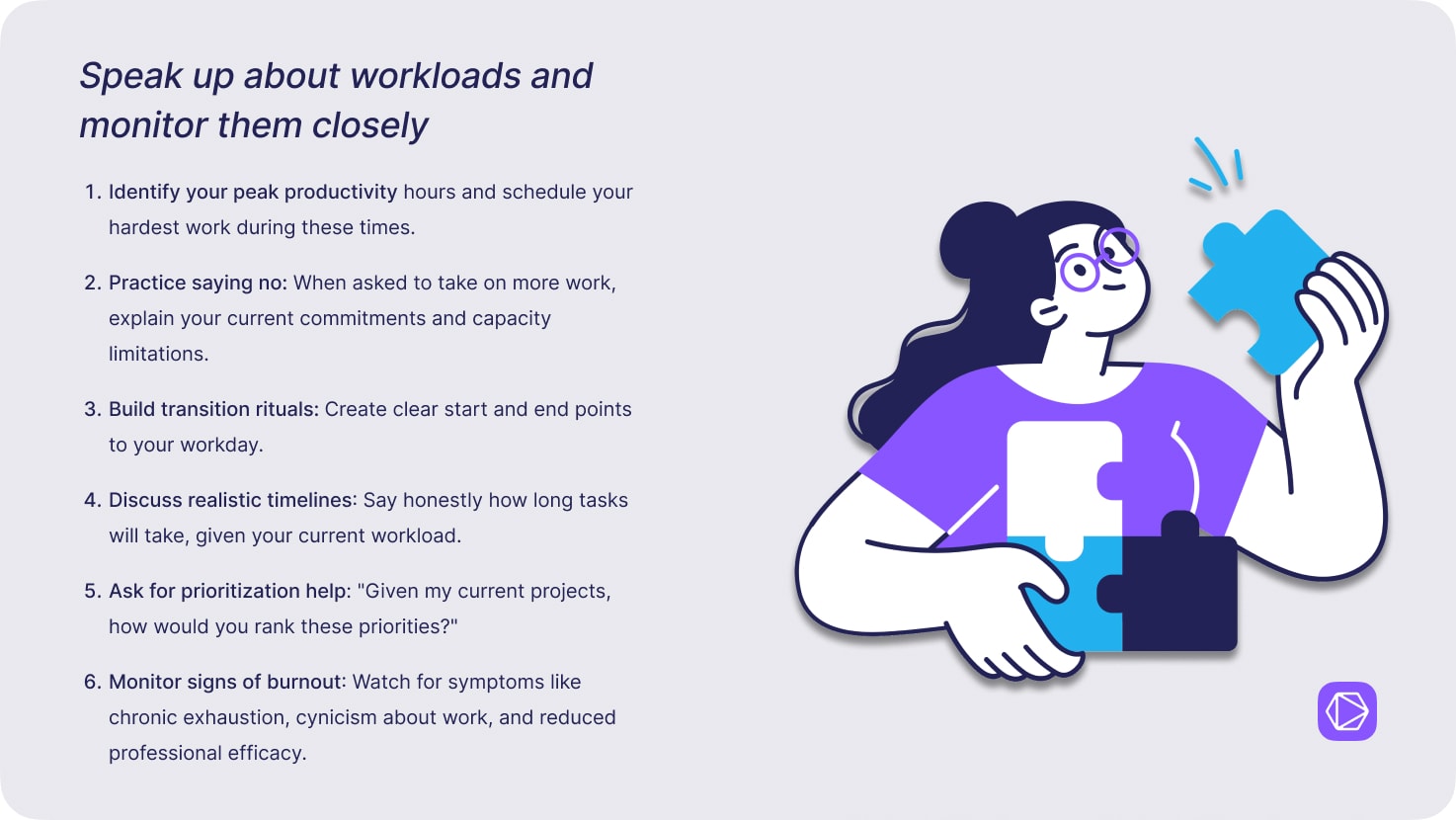
2. Speak up about workloads and monitor them closely
Don’t suffer in silence if you’re consistently overworked, but actively manage your energy and workloads in the following ways:
- Identify your peak productivity hours: Schedule your most demanding tasks during these times. I’m a morning person who does my best thinking before noon, so I save admin tasks for late afternoon when my brain is naturally less sharp.
- Practice saying no: When asked to take on more work, explain your current commitments and capacity limitations. Try: “I’d love to help with that project, but I’m at capacity with the Henderson account until next month. Could we revisit this then, or is there someone else who might have bandwidth now?”
- Build transition rituals: Create clear start and end points to your workday, like a morning planning session and an evening wrap-up. I end each day by writing tomorrow’s top three priorities and shutting down my computer completely, which is a physical signal that work is done.
- Discuss realistic timelines: When assigned new work, provide honest assessments of how long tasks will take, given your current workload, and ask for capacity planning to be done accordingly.
- I’ve found that saying, “I can deliver quality work on this by Friday,” works better than explaining why Wednesday is impossible.
- Ask for prioritization help: When everything seems urgent, ask your manager: “Given my current projects, how would you rank these priorities?”. Also, apply some of the simplest and best prioritization methods out there. This shifts the burden of impossible choices to the person with the authority to make them.
- Monitor signs of burnout: Watch for symptoms like chronic exhaustion, cynicism about work, and reduced professional efficacy. When I notice myself becoming unusually irritable about minor work issues, it’s a reliable warning sign that I need to dial back.
💡 Pro tip: Implement techniques for how to increase focus and concentration during regular work hours. Simple time management strategies like practicing deep work or time-blocking can do wonders.
Ready, set, implement overtime reduction strategies!
Looking for ways to reduce overtime to reduce overtime is one of the healthiest activities that both managers and employees can do. Ultimately, it’s not only about saving money but about saving something much more valuable: health, creativity, and joy.
Breaking free from the overtime trap requires courage from both managers and employees. It means challenging the “always-on” mentality that’s become so normalized in our work culture. It means valuing quality over quantity, results over appearances, and sustainability over heroics.
I’ve been on both sides of this equation, the burnout employee working nights and weekends, and later, the manager trying to build a healthier team culture. The transformation isn’t always easy, but it’s always worth it.
FAQs
Is all overtime bad?
No, occasional overtime to meet genuine business needs is normal and can even be energizing when it’s purpose-driven and followed by adequate recovery time. The problem is when overtime becomes chronic and expected rather than exceptional. I actually enjoy the occasional all-hands-on-deck moment when a true emergency hits – it’s the constant grind of regular overtime that damages morale and health.
What’s the difference between reducing overtime and time management?
Time management focuses on individual efficiency within given hours, while reducing overtime addresses systemic issues like workload distribution, staffing levels, and cultural expectations. Both are important but operate at different levels—personal effectiveness versus organizational structure. No amount of personal productivity can solve fundamentally broken systems or unrealistic expectations.
Sources
https://economics.stanford.edu/publications/diminishing-returns-work-consequence-long-working-hours
https://pmc.ncbi.nlm.nih.gov/articles/PMC2910393
https://www.mckinsey.com/featured-insights/mckinsey-explainers/what-is-burnout